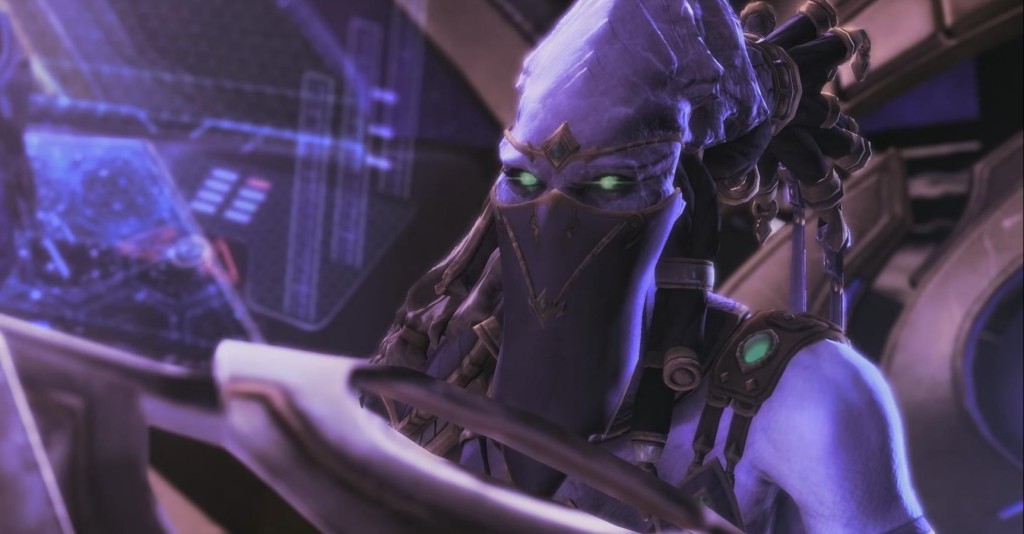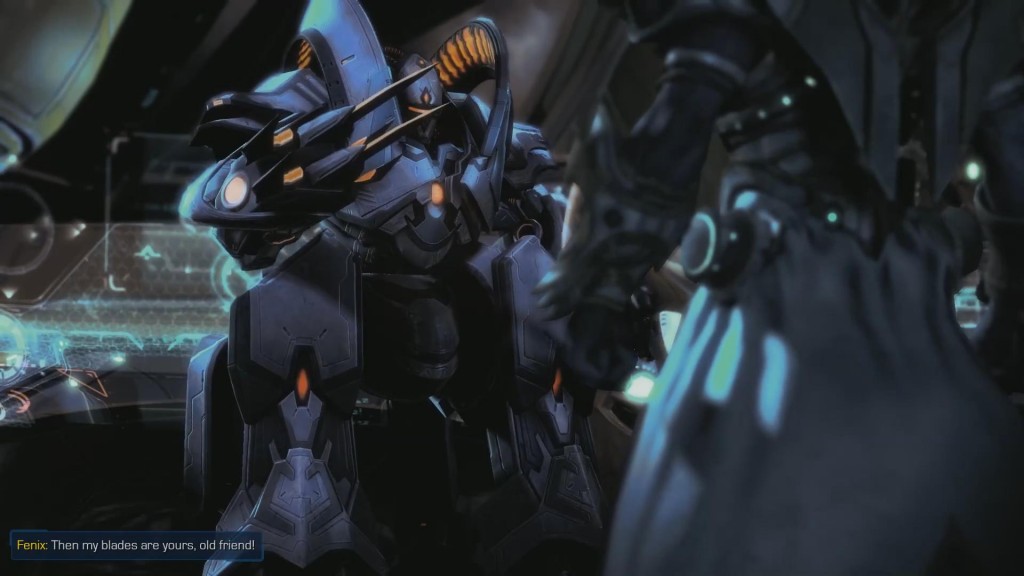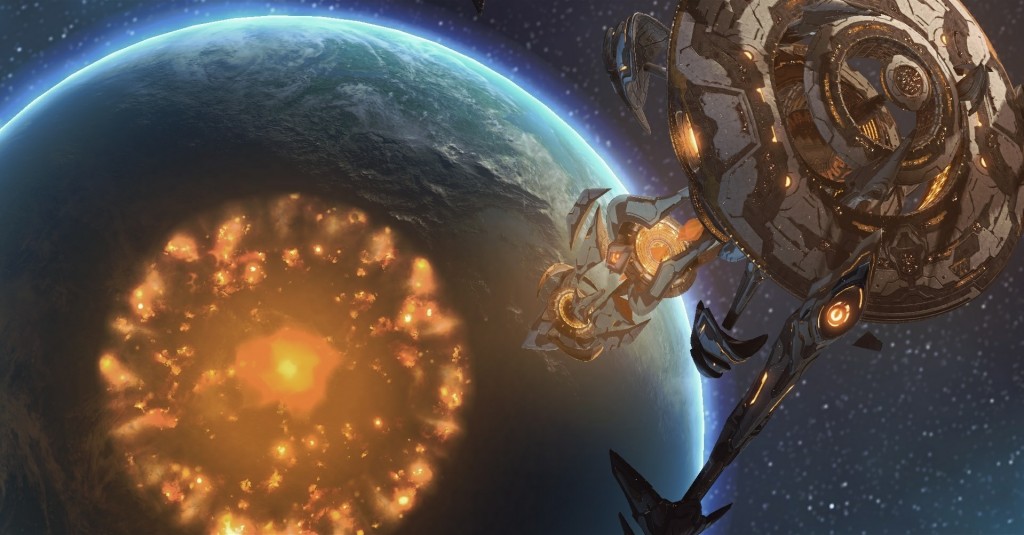Pale, crumbled skin and brightly glowing blue eyes. A weak but upright figure, covered in heavy, hovering armor and a blade of pure psi-energy on each arm. The Protoss of the StarCraft universe are masters in complementing their seemingly weak physiology with highly advanced technology to produce an impressive appearance. It is their leader, Artanis, who sets out to fight in a conflict of good and evil in the newest title of the StarCraft series: Legacy of the Void (2015). At least, that’s what the general perception of the game’s story seemed to be after its release last year. It’s a perception that falls short of Legacy of the Void’s actual potential. Although often reduced to the tired theme of good versus evil, in reality, the game’s story displays subtle commentary on contemporary cultural and ethical issues.

That media artifacts such as books and movies are representative of the time they were created in isn’t anything new. If you read Effi Briest (1894), you get a glimpse of society and life in the 19th century. In his 2004 book Das Netz und die virtuelle Realität (The net and the virtual reality), Jens Schröter describes the alien race Borg in Star Trek as indicative of the fear of the internet and egalitarianism during the 1970s and 80s. The Borg are a highly advanced race of cyborgs, who are connected in a collective hivemind, through which each ‘drone’ has access to the knowledge and thoughts of every other drone. Once assimilated into the collective, individuals are improved by replacing body parts with technology and differences such as race or gender are erased, as they are irrelevant to the drone’s function. This creates a ‘society’ without lies and conflicts, in which everyone is equal. The contrast of the totalitarian and egalitarian Borg to the more individualistic (human) Federation indicates the aforementioned cultural fears. StarCraft can be read in a similar way.
The Protoss’s emotions and thoughts are connected to each other, very similar to the Borg’s hivemind. This connection, the Khala, is established by nerve cords at the Protoss’s heads, which look very much like dreadlocks, and is considered one of the most sacred artifacts of Protoss culture. The ‘light of the Khala’, though, is depicted much more positively than the Borg’s hivemind. One reason for this might be that the Protoss remain individuals and the Khala is rather a very advanced tool of communication, despite the way it connects thoughts and emotions means that telling lies to another Protoss is impossible.
Understanding the Protoss’s culture as a mirror of our own culture’s values, it seems we too have accepted a certain degree of constant connectedness, as long as everyone’s status as an individual isn’t restricted. We are not far from the Khala’s omnipresence. Through social networks we voluntarily publish the most private parts of our lives. Smartphones make us available for calls, texts, emails and any other kind of message, at any point in time and space. Applications are gathering as much data as possible about movement profiles, behaviors and preferences. If all this data was available to everyone in the network, we would have arrived at a 21st century version of the Khala. Fortunately the data’s degree of availability is constantly negotiated between companies, the government, and civil rights movements, the latest example being Apple’s refusal to unlock a suspect’s iPhone for the FBI. Interestingly, the gathering of data has drifted into the background in recent years, and the biggest concerns now are who might use the network and data in what evil way. The fear of the technology itself, as described by Schröter in the Borg’s case, has transformed into concerns about its security: in Legacy of the Void, the antagonist, Amon, enters the Khala, corrupts it and thereby gains control over all Protoss who are connected by it.
One stream of Protoss culture isn’t affected by Amon’s actions and can therefore help in the fight against him. This is the so-called Nerazim (or Dark Templar), who denied the Khala’s light long before the events of Legacy of the Void, and made it part of their culture to sever their nerve cords. The result is the disconnection from the Protoss collective mind and ultimately their exile by the Protoss Conclave. While this act itself would be worthy of a discussion on how we treat deviant behavior and beliefs, there is a much larger issue that caught my attention: the destruction of Shakuras, which is the Nerazim’s adopted homeworld in Legacy of the Void.

After Shakuras is overrun by enemy forces, Artanis, as the leader of the Protoss armada, initially objects to the planet’s destruction but is convinced by Shakuras’s native matriarch Vorazun that it is her choice, as it was her tribe that built their home on the planet. Their plan is to lure as many of Amon’s Zerg on to Shakuras and eventually to destroy Shakuras, which would cause vast casualties to Amon’s forces. It is a heroic act of sacrifice. Or is it? In 2009, Carl David Mildenberger discussed types and sources of motivations for evil regarding the issue of suicide ganking in EVE Online (2003). One part of his discussion included the examination of the deed’s outcome for the perpetrator. In suicide ganks, stronger players attack weaker players in protected areas to obtain goods, all while their own ships are being destroyed. Due to this destruction, the economical outcome for the ganker is in most cases negative. We can easily argue that this is an act of evil: the perpetrator does not gain anything from this aggression towards a weaker player.
Similarly, the only gain the Protoss alliance gets from the destruction of Shakuras is the decimation of Amon’s forces. The actual advantage and necessity of this outcome remains unknown and the damage is not a spaceship, but a whole planet. A planet on which possibly hundreds of Nerazim and at least one other species lives. It’s also worth noting that the world existed long before the Nerazim went there, and it would exist long after the Protoss are gone. It is hard to justify the destruction of something one didn’t create and the matriarch’s motives seem rather egoistical: “I will not let this world be a den to Amon’s forces. Worlds may fall to ash. What matters is that we endure”. Who is she to make this decision? If Vorazun’s act stays unquestioned, the razing of cities during military conflict with the reason “So they can’t have it” would be perfectly justifiable.
Additionally the matriarch’s position has much more subtle, and severe, consequences. For decades mankind strived to improve its own efficiency and standard of living, disregarding the damages we cause to our planet. We burn fossil fuels that took millions of years to form, polluting our atmosphere to a soon irreversible degree. We eradicate whole races of animals for our own convenience or pleasure and are cutting down ancient forests to make room for our agricultural ‘needs’. It is the matriarch’s mindset that led us to this situation and Legacy of the Void’s glorification of Shakuras’s destruction is yet another indication of the fraudulence of our—by human egoism permeated—ethical values. Or, in other words: no, it does not matter “that we endure”, at least not at all cost.

During their struggle against Amon, the Nerazim aren’t Artanis’s only allies. He also seeks the help of the Purifiers—machines, infused with copies of great Protoss warriors’ minds who were once abandoned by the Conclave as well. The first Purifier to be saved from destruction turns out to be a replicant of Fenix, Artanis’s old friend. As one of the Protoss’s engineers describes the copy’s accuracy at around 99 percent, a discussion about who we are and how we become what we are evolves. Artanis asks who we were if only one percent of a lifetime’s decision were made differently or not at all. It is this question that confuses the freed ‘machine’ Fenix about his own identity. He has all memories of the person once called Fenix, but from the very moment of ‘rebirth’ he started making his own decisions. An experience we all had after the transition from one social or cultural environment into another one. The experience of being able to become someone completely different and the struggle to grasp this possibility, as we are held back by the memories of what we did and who we were. What is a matter of identity in our case, is a problem of existence for Fenix, who, step by step, develops his position from ‘I must know the truth of what I am’, over ‘I am synthetic, a replication… a lie. I am not Fenix’, to his final decision to give himself a new name: Talandar—“One with the strong heart.”
Legacy of the Void not only shows the struggle of the individual Talandar, but also leads us to the arrogance and contempt towards this creation inside the Protoss’s culture, which is well summarized by Artanis’s statement “They were and are still only machines. Do not give them such credence, Karax”. This position will certainly be prominent in our own society, after the creation of the first superintelligence and, in fact, scientists are already discussing this complex of problems. In 2011, Elizier Yudkowsky and Nick Bostrom described the commonly proposed criteria for the qualification as a moral being as “sentience: the capacity for phenomenal experience or qualia, such as the capacity to feel pain and suffer” and “sapience: a set of capacities associated with higher intelligence, such as self-awareness and being a reason-responsive agent”. While the mechanical warrior Talandar’s ability to experience pain or suffering is unknown, he is most certainly sapient, shown by his ability to make autonomous, rational decisions and reflect on his own existence. This doesn’t stay unnoticed by the Protoss leader Artanis, who eventually concludes that a ‘machine’s’ sapience is sufficient for a status as moral being.
The leader’s progressive mindset towards the moral status of sapient machines slowly turns the opinion of most characters from hostile towards a more friendly one and he convinces the mechanical Purifiers to join him by promising them autonomy and a position at his side “as equals”. In an age where artificial superintelligence is broadly discussed, machines are able to beat humans in the most complicated games and even take employee positions in companies, Talandar’s and the Purifiers’s story is a statement: digitized minds won’t stay copies of the originals for long and artificial intelligence shouldn’t be seen as mere machines. It lies in their nature to develop, make their own decisions, and become autonomous individuals. Further, we shouldn’t see such creations as abominations, but treat them with respect and ascribe them a right to exist, just as any other being. As the Protoss’s highest ranked engineer states: “We too are machines of a biological nature. I often marvel at the architecture, the design, the careful construction of our form, our machinery”. Ultimately, Talandar’s act of renaming himself is not only the emancipation of whoever Fenix, the ‘original’, was before him, but his rightful claim of existence as a moral being in the universe. This position has important implications for the future treatment of AIs or replicated minds, and while a videogame should probably not be the basis for a political decision, Legacy of the Void participates in a contemporary discourse, joining media products such as Ghost in the Shell (1995), Transcendence (2014), Automata (2014) and, to name at least one other videogame, The Talos Principle (2014).

Interestingly, the first act of Artanis’s new ally after their release from stasis is to purify the moon Endion, which their ship was orbiting, from Amon’s Zerg, but effectively destroying all life on it. This poses another atrocity performed by the supposedly ‘good’ in Legacy of the Void. All these events are just a fraction of what is happening in the game’s story. There is much more to it, with the Protoss leader Artanis discussing matters of epistemology, or “What do we know and how can we actually know anything?”, with one of his engineers; the Nerazim’s matriarch, Vorazun, describing Humans as lesser beings and Artanis defending them, raising the question of how we decide if something or someone is worth less than us; Artanis and Alarak—another Protoss tribe leader—debating different methods of leadership and the whole Protoss alliance depicting discrepancies due to cultural differences between the Templar (Artanis), Nerazim (Vorazun) and Tal’Darim (Alarak).
Superficially, Legacy of the Void’s story is about a conflict between good and evil, and the stake is the whole universe. If we look closer though, this perception has to be questioned. Considering the Protoss’ alliances deeds—especially Shakuras’s destruction and the purification of Endion—the conflict is ethically seen a dispute between Evil and a lesser Evil. Besides the Amon versus Protoss conflict, Legacy of the Void’s story is about the Protoss’s struggle to overcome cultural differences within their own species as well as across species. It is about an entity lost in its own existence, striving for an understanding of what he is, and a whole civilization’s disdain towards him, their own creation.
